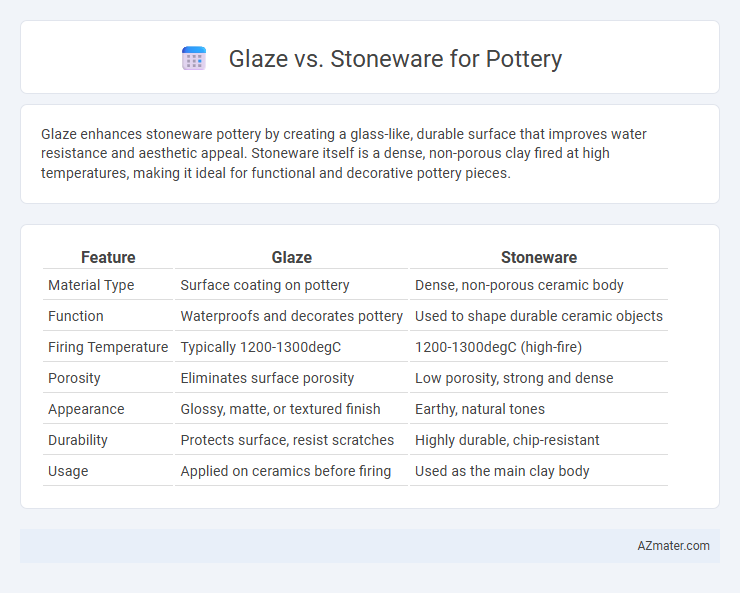Glaze enhances stoneware pottery by creating a glass-like, durable surface that improves water resistance and aesthetic appeal. Stoneware itself is a dense, non-porous clay fired at high temperatures, making it ideal for functional and decorative pottery pieces.
Table of Comparison
| Feature | Glaze | Stoneware |
|---|---|---|
| Material Type | Surface coating on pottery | Dense, non-porous ceramic body |
| Function | Waterproofs and decorates pottery | Used to shape durable ceramic objects |
| Firing Temperature | Typically 1200-1300degC | 1200-1300degC (high-fire) |
| Porosity | Eliminates surface porosity | Low porosity, strong and dense |
| Appearance | Glossy, matte, or textured finish | Earthy, natural tones |
| Durability | Protects surface, resist scratches | Highly durable, chip-resistant |
| Usage | Applied on ceramics before firing | Used as the main clay body |
Understanding Glaze in Pottery
Glaze in pottery is a glass-like coating fused to stoneware surfaces through high-temperature firing, enhancing durability and aesthetic appeal. It serves as a protective barrier against water and stains, while offering vibrant colors and textures that vary based on mineral composition and firing conditions. Understanding glaze properties such as glossiness, matte finish, and chemical resistance is essential for selecting the right combination with stoneware to achieve both functional and artistic goals.
What is Stoneware?
Stoneware is a durable, non-porous type of pottery fired at high temperatures between 1,200degC and 1,300degC, resulting in a dense, vitrified body that resists chipping and cracking. Unlike earthenware, stoneware is typically more robust and ideal for functional items like dinnerware and cookware due to its strength and water resistance. When combined with glaze, stoneware achieves a smooth, glass-like surface that enhances both its aesthetic appeal and usability.
Key Differences Between Glaze and Stoneware
Glaze is a glass-like coating applied to pottery surfaces that provides waterproofing, color, and texture, whereas stoneware is a type of durable ceramic material fired at high temperatures. Stoneware pottery is naturally vitrified, making it non-porous and strong, while glaze enhances both aesthetic appeal and functionality by creating a smooth, often glossy finish. The key difference lies in glaze being a surface treatment and stoneware being the clay body itself, each contributing distinct characteristics to the final ceramic piece.
Benefits of Using Glaze in Pottery
Glaze in pottery enhances durability by creating a glass-like surface that resists water, stains, and scratches, unlike unglazed stoneware which is more porous and prone to damage. It also allows for a wide array of vibrant colors and textures, providing aesthetic versatility that raw stoneware cannot achieve. Furthermore, glazing improves food safety by sealing the pottery, making it non-porous and hygienic for everyday use.
Advantages of Stoneware Pottery
Stoneware pottery offers superior durability and chip resistance due to its high firing temperature, making it ideal for everyday use and functional items. Its dense, non-porous body resists water absorption without requiring a glaze, ensuring long-lasting strength and minimal maintenance. The natural earthy tones and varied textures of stoneware also provide a unique aesthetic appeal that enhances handmade pottery designs.
Durability: Glaze vs Stoneware
Stoneware is a type of ceramic known for its high durability and strength, making it resistant to chipping and cracking even under heavy use. Glaze acts as a protective coating applied to both stoneware and other pottery types, enhancing surface hardness, preventing absorption, and providing resistance to stains and scratches. While stoneware provides a solid structural base, the glaze significantly increases overall durability by sealing the porous surface and improving food safety and ease of cleaning.
Aesthetic Appeal: Glaze Effects vs Natural Stoneware
Glaze enhances pottery with vibrant colors, glossy or matte finishes, and intricate patterns, offering unlimited aesthetic customization through chemical formulations and firing techniques. Natural stoneware boasts earthy tones, subtle textures, and a rustic charm that emphasizes organic beauty and material authenticity without added surface treatments. The choice between glaze and natural stoneware hinges on desired visual impact--glaze for dynamic, polished effects, and stoneware for understated, tactile appeal.
Suitability for Everyday Use
Stoneware pottery is highly suitable for everyday use due to its durability, chip resistance, and ability to withstand high temperatures, making it ideal for regular handling and dishwasher safety. Glaze enhances stoneware by providing a non-porous, stain-resistant surface that simplifies cleaning and adds aesthetic appeal. The combination of sturdy stoneware and functional glaze ensures that dishes maintain longevity and performance under frequent use in kitchens and dining settings.
Maintenance and Care Comparison
Glaze provides a smooth, non-porous surface on pottery, making it easier to clean and resistant to stains, while stoneware's natural porosity requires sealing to prevent water absorption and damage. Maintenance of glazed pottery involves gentle cleaning with mild detergents and avoiding abrasive scrubbers to preserve the finish. Stoneware demands routine sealing and careful drying to avoid cracking and prolonged exposure to moisture, increasing overall care requirements compared to glazed pieces.
Choosing Between Glaze and Stoneware for Your Pottery Projects
Choosing between glaze and stoneware for pottery projects depends on your desired finish and durability requirements. Stoneware offers a dense, non-porous body that withstands high temperatures, making it ideal for functional pottery like dinnerware. Glaze provides a customizable, protective coating that enhances aesthetics and seals the pottery, preventing water absorption and increasing longevity.

Infographic: Glaze vs Stoneware for Pottery
 azmater.com
azmater.com